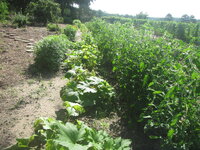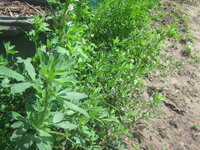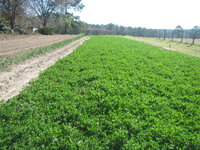The Hail last night was small by Texas standards, and I found the garden to be in great shape.
This might be an appropriate time to introduce my veggie garden. I consider my veggie garden in three zones: zone 1, zone 2, zone 3. Each zone includes about 4-5 rows that are app 2ft wide by 80 ft long give or take. Each zone has its own rotation program and soil building program.
Let me introduce my zones starting with Zone 1 pictured below.
Zone 1 is bordered on the left by a fledging flower bed with various marigolds, geraniums, chrysanthemums, blue borage, sunflowers, nasturtiums, lantana, and mock orange among others. To the left of the flowers is a row of yellow crookneck squash, magda squash, and zucchini squash followed by navy beans finishing out the row. Next over are the tomatoes which include Texas super sweet 100's, roma, whoppers, tycoon, bella rosa, purple Cherokee, and cranberry beans finishing out the row. Interspersed with the tomatoes are the tomatillos and several basil and peppermint plants.

Zone 2 is immediately to the right of Zone 1 and shows several rows that are currently in soil refurbishment process which begins with application of several inches of composted animal manure, discing, then a cover crop, chop and drop, and green manure incorporation...all of which leads to soil that tests out " No N P K required" with nutrient density scores well above 90% without any artificial/synthetic fertilizers whatsoever. My preferred summer cover crop is Sunn Hemp and I also use cow peas. Winter cover crops include alfalfa, clovers, vetch, turnips, radishes, etc. .
These rows recently housed my fall/winter veggies including broccoli, cabbage, kale, daikon radish, red radish, beets, turnips, lettuce, carrots, mizuna, spinach, collards, and brussels sprouts and a few others.
Also, this zone contained my just recently harvested onion crop (over 200 pounds of Texas super sweet 1015 onions), my potato crop (over 200 pounds of red, white, and mixed potato varieties) and yet to be harvested soft neck garlic.
On the right of this zone 2 are my Hügelkultur containers (about 20) that are growing various mostly experimental crops including horseradish, carrots, corn, onions, etc.. The row is completed by a bean/cucumber/melon trellis made of 16 ft cattle panels and currently growing bingo beans, various cucumber varieties, and blue lake pole beans.

Zone 3 has the crops that will take us into summer including multiple varieties of okra, purple hull peas, two plantings of blue lake bush green beans, two plantings of Honey select corn, soon to be planted Murasaki and Asian sweet potatoes, blackberries which are loaded right now with ripe berries, and two types of sunflowers which serve as insect trap plants.

It all seems to be in great shape in spite of terrible recent torrential rains. I hope you enjoyed the "tour"





